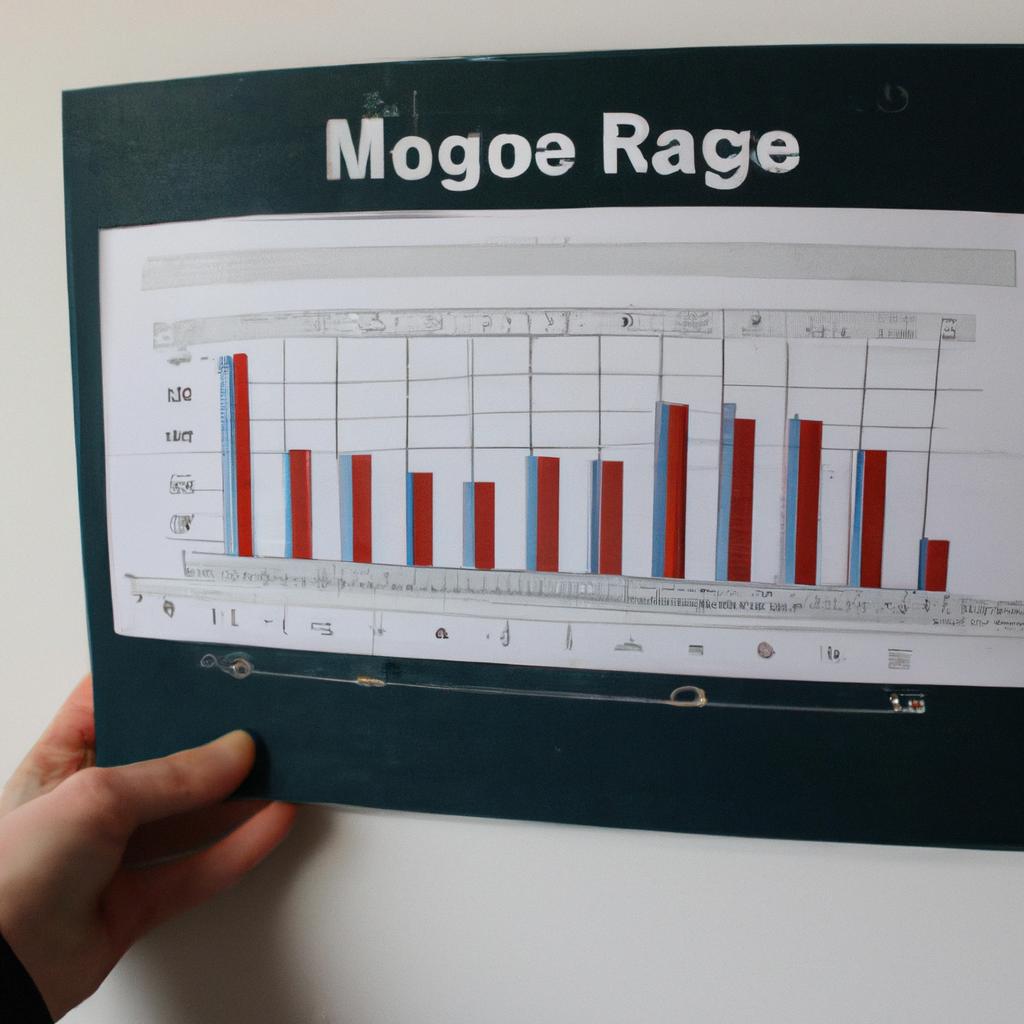Fixed-rate mortgages have long been a popular choice for homebuyers seeking stability and predictability in their mortgage payments. With this type of mortgage, the interest rate remains fixed throughout the entire term, providing borrowers with peace of mind knowing that their monthly payments will not fluctuate. For instance, let’s consider a hypothetical scenario where John purchases a house using a fixed-rate mortgage. Regardless of any changes in market conditions or economic fluctuations, John can rest assured that his monthly mortgage payments will remain constant over the duration of his loan.
Understanding key insights on mortgage rates is essential for individuals considering a fixed-rate mortgage as it allows them to make informed decisions about their financial future. One significant factor influencing fixed-rate mortgages is the prevailing interest rates set by central banks. When central banks increase or decrease these rates, it directly impacts the overall cost of borrowing for consumers. Additionally, factors such as inflation levels, economic indicators, and lender policies also play crucial roles in determining mortgage rates. By examining these various elements together, potential homebuyers can gain valuable insights into how mortgage rates are established and evaluate whether a fixed-rate mortgage aligns with their long-term financial goals.
Understanding Fixed-Rate Mortgages
Imagine a scenario where you are planning to purchase your dream home. You have done your research, identified the perfect property, and now it’s time to secure financing. One of the most common options available to borrowers is a fixed-rate mortgage. This type of mortgage offers stability and predictability by providing an interest rate that remains constant throughout the loan term.
To better understand fixed-rate mortgages, let us delve into their key features and benefits:
1. Consistent Monthly Payments: With a fixed-rate mortgage, borrowers can enjoy consistent monthly payments over the life of the loan. This feature provides peace of mind as there will be no unexpected increases in payment amounts due to fluctuating interest rates.
2. Protection Against Rate Fluctuations: Unlike adjustable-rate mortgages (ARMs), which are subject to changes in market conditions, fixed-rate mortgages shield borrowers from fluctuations in interest rates. Regardless of how economic factors impact overall lending rates, the interest rate on a fixed-rate mortgage remains unchanged.
3. Long-Term Financial Planning: Fixed-rate mortgages allow for more accurate long-term financial planning since borrowers know precisely what their monthly housing costs will be for years to come. This stability enables individuals and families to budget effectively and make informed decisions about other aspects of their finances.
4. Peace of Mind: Knowing that your mortgage payment amount will remain steady month after month brings a sense of security and peace of mind. It eliminates concerns about potential spikes in housing expenses and allows homeowners to focus on building equity and enjoying their homes without worrying about unpredictable changes in their financial obligations.
Consider this hypothetical example: A family decides to purchase their first home using a 30-year fixed-rate mortgage at an annual interest rate of 4%. They borrow $250,000, resulting in a monthly principal and interest payment of approximately $1,193. Throughout the entire loan term, spanning three decades, these borrowers will pay a consistent amount every month, only varying if there are changes in property taxes or homeowners insurance.
In summary, fixed-rate mortgages offer borrowers stability, predictability, and peace of mind by providing consistent monthly payments and protection against rate fluctuations. Now that we have explored the fundamentals of fixed-rate mortgages, let us turn our attention to the factors that influence mortgage rates.
Factors That Influence Mortgage Rates
Understanding Fixed-Rate Mortgages: Key Insights on Mortgage Rates
Imagine you are a potential homebuyer, eager to find the perfect mortgage loan for your dream house. As you begin researching different options, one type of mortgage that often catches your attention is the fixed-rate mortgage. Let’s delve deeper into this popular choice and explore key insights regarding mortgage rates.
Mortgage rates play a crucial role in determining the overall cost of financing your home. These rates represent the interest charged by lenders on the amount borrowed, impacting both monthly payments and long-term affordability. Understanding how these rates are determined can help you make informed decisions when selecting a fixed-rate mortgage.
To shed light on this matter, consider an example where two individuals with identical credit scores apply for a fixed-rate mortgage from different lenders. Despite having similar financial profiles, they end up receiving different interest rate quotes. This discrepancy arises due to various factors that influence mortgage rates:
-
Economic Factors:
- Inflation expectations
- The state of the national economy
- Government monetary policies
-
Market Conditions:
- Supply and demand dynamics
- Investor sentiment towards bonds
-
Individual Creditworthiness:
- Credit score
- Debt-to-income ratio
-
Loan Characteristics:
- Loan term length (e.g., 15 years vs. 30 years)
- Down payment percentage
By analyzing these factors, lenders assess the level of risk associated with each borrower and determine an appropriate interest rate accordingly.
It is essential to recognize that although borrowers have limited control over some influencing factors like economic conditions or market sentiments, there are measures one can take to improve their chances of securing better rates. For instance, focusing on maintaining a strong credit profile and saving for a higher down payment can positively impact the offered interest rate.
In our next section, we will discuss in detail the benefits of opting for a fixed-rate mortgage. By understanding the advantages, you will be able to make an informed decision when choosing your ideal mortgage loan. So let’s explore how fixed-rate mortgages can provide stability and financial security in the world of homeownership.
Benefits of Fixed-Rate Mortgages
Fixed-Rate Mortgages: Key Insights on Mortgage Rates
In the previous section, we explored the various factors that influence mortgage rates. Now, let’s delve further into how these factors affect fixed-rate mortgages specifically. To illustrate this, consider a hypothetical scenario where two individuals with identical credit scores and down payments apply for a 30-year fixed-rate mortgage from the same lender.
Firstly, one key determinant of mortgage rates is economic conditions. In our example, if there is an economic downturn characterized by low inflation and slow growth, lenders may offer lower interest rates to stimulate borrowing and support the housing market. Conversely, during periods of robust economic growth and high demand for loans, lenders may increase mortgage rates as a means to manage risk.
Secondly, borrower-specific characteristics play a significant role in determining mortgage rates. Lenders typically assess factors such as credit score, debt-to-income ratio, employment history, and loan amount when evaluating an applicant’s creditworthiness. In our case study, both applicants have excellent credit scores and stable employment histories. As a result, they are likely to be offered favorable interest rates due to their perceived low risk.
Thirdly, market competition among lenders can impact mortgage rates. When multiple financial institutions compete for borrowers’ business, they may adjust their rates to attract customers. Our hypothetical borrowers might find themselves benefiting from competitive pricing as different lenders vie for their attention.
To better understand the potential emotional impact of choosing a fixed-rate mortgage over other options, consider the following bullet points:
- Peace of mind knowing that your monthly payments will remain constant throughout the life of the loan.
- Protection against rising interest rates in the future.
- Ability to budget effectively without worrying about fluctuating payment amounts.
- Confidence in long-term financial planning knowing exactly what you owe each month.
Additionally, here is a table comparing some advantages of fixed-rate mortgages:
| Advantages | Description |
|---|---|
| Rate stability | Fixed-rate mortgages offer predictable monthly payments. |
| Budget-friendly | They allow for effective financial planning and budgeting. |
| Protection against inflation | Rates remain the same, even if market interest rates rise. |
| Peace of mind | Borrowers can rest assured that their mortgage won’t change. |
In summary, various factors influence mortgage rates, including economic conditions, borrower-specific characteristics, and market competition among lenders. In our hypothetical case study, both applicants with excellent credit scores and stable employment histories are likely to receive favorable interest rates due to their low perceived risk. Choosing a fixed-rate mortgage offers emotional benefits such as peace of mind, rate stability, protection against rising interest rates, and improved long-term financial planning.
Moving forward into the next section on “Comparison: Fixed-Rate vs. Adjustable-Rate Mortgages,” we will explore how fixed-rate mortgages stack up against adjustable-rate mortgages in terms of their features and suitability for different borrowers’ needs.
Comparison: Fixed-Rate vs. Adjustable-Rate Mortgages
Fixed-Rate Mortgages: Key Insights on Mortgage Rates
Benefits of Fixed-Rate Mortgages (Continued)
When considering the benefits of fixed-rate mortgages, it is essential to understand how mortgage rates play a crucial role in determining the overall cost and stability of homeownership. To illustrate this point, let’s consider an example scenario. Imagine a prospective homebuyer named Sarah who is planning to purchase her first house. Sarah decides to opt for a 30-year fixed-rate mortgage at an interest rate of 3.5%. This choice provides her with several advantages:
-
Predictable Monthly Payments: With a fixed-rate mortgage, Sarah knows exactly what her monthly payments will be throughout the entire loan term. This predictability allows her to budget more effectively and avoid any surprises due to fluctuating interest rates.
-
Protection Against Rate Increases: If market interest rates rise during the life of Sarah’s mortgage, her monthly payments remain unaffected since she has locked in her rate at 3.5%. This protection offers peace of mind and shields her from potential financial strain caused by rising borrowing costs.
-
Long-Term Stability: A fixed-rate mortgage ensures that Sarah’s principal and interest payments stay constant over time, regardless of economic conditions or inflationary pressures. This stability provides security and helps her plan for other long-term financial goals.
-
Easier Financial Planning: By knowing exactly when their mortgage will be paid off, borrowers like Sarah can plan ahead for future expenses such as college tuition fees or retirement savings without the uncertainty associated with adjustable-rate mortgages.
The significance of these benefits becomes even clearer when we compare fixed-rate mortgages against adjustable-rate mortgages (ARMs). The next section will delve into this comparison in detail, highlighting key considerations that homebuyers need to evaluate before making their final decision.
As you embark on your journey to find the best-fixed rate mortgage for your needs, it is vital to be well-informed and prepared. By following these guidelines, you can make a more confident decision:
-
Shop around for rates: Take the time to compare mortgage rates from multiple lenders. This step will help you find the most competitive rate available in the market.
-
Evaluate closing costs: In addition to interest rates, consider other fees associated with obtaining a mortgage, such as origination fees or points. These costs can significantly impact the overall affordability of your loan.
-
Understand prepayment penalties: Some mortgages may impose penalties if you pay off your loan earlier than expected. Make sure to inquire about any potential charges related to prepaying your mortgage.
-
Seek professional advice: Consulting with a qualified mortgage broker or financial advisor can provide valuable insights into understanding complex terms and conditions that may affect your mortgage’s long-term cost and viability.
By taking these steps, you increase your chances of finding a fixed-rate mortgage that aligns with both your short-term affordability and long-term financial goals.
Now let’s explore how fixed-rate mortgages stack up against adjustable-rate mortgages (ARMs), weighing their respective advantages and disadvantages to help you determine which option suits your unique circumstances best.
Tips for Finding the Best Fixed-Rate Mortgage
Fixed-Rate Mortgages: Key Insights on Mortgage Rates
Comparison: Fixed-Rate vs. Adjustable-Rate Mortgages
Now that we have examined the key differences between fixed-rate and adjustable-rate mortgages, let us delve deeper into the factors affecting mortgage rates for fixed-rate loans. Understanding these insights will empower potential homebuyers to make informed decisions when selecting a mortgage.
One important aspect to consider is the overall state of the economy. Economic conditions play a significant role in determining interest rates offered by lenders. For instance, during periods of economic growth and stability, interest rates tend to rise due to increased demand for credit. Conversely, during economic downturns or recessions, central banks often lower interest rates as part of their monetary policy measures to stimulate borrowing and spur economic activity.
Another critical factor impacting mortgage rates is inflation. Inflation refers to the general increase in prices over time, eroding the purchasing power of money. Lenders take inflation into account when setting interest rates for fixed-rate mortgages. If inflationary pressures are expected to be high in the future, lenders may adjust mortgage rates accordingly to protect against potential losses caused by rising costs.
Furthermore, market forces such as supply and demand dynamics also influence mortgage rates. When there is greater competition among lenders or an excess supply of funds available for lending purposes, mortgage rates are likely to decrease. On the other hand, if there is limited capital availability or heightened demand for loans from borrowers, lenders may raise interest rates accordingly.
To illustrate how these factors interplay with mortgage rates, imagine a scenario where a prospective homebuyer named Sarah is considering obtaining a fixed-rate mortgage loan. Here are some key insights she should keep in mind:
- The current state of the economy can impact her decision-making process.
- Anticipating future inflation levels will help her assess whether locking in an interest rate now would be advantageous.
- She should monitor market trends closely as fluctuations in supply and demand can affect interest rates.
- Peace of mind: Fixed-rate mortgages offer stability and predictability, providing a sense of security for homeowners.
- Financial planning: With fixed monthly payments, budgeting becomes more manageable, allowing individuals to plan their finances effectively.
- Long-term commitment: Committing to a fixed-rate mortgage demonstrates confidence in future financial stability and long-term property ownership.
- Protection against rising rates: By securing a fixed rate now, borrowers shield themselves from potential increases in mortgage rates over time.
In addition to these insights, it is essential to understand how different economic factors interact with mortgage rates. The table below highlights some key considerations:
| Economic Factor | Impact on Mortgage Rates |
|---|---|
| Economic Growth | Higher growth often leads to higher mortgage rates due to increased demand for credit. |
| Inflation | Expectations of high inflation may lead lenders to raise mortgage rates as protection against rising costs. |
| Market Forces | Competition among lenders or excess capital supply generally results in lower mortgage rates. |
Understanding the relationship between these factors allows prospective homebuyers like Sarah to make informed decisions when comparing various loan options and selecting the most suitable fixed-rate mortgage.
Common Misconceptions About Mortgage Rates
Moving forward, let us address common misconceptions surrounding mortgage rates and shed light on important aspects that borrowers should be aware of before entering into any financing agreements.
Common Misconceptions About Mortgage Rates
Having discussed some valuable tips for finding the best fixed-rate mortgage, it is essential to address common misconceptions that often surround mortgage rates. By understanding these misconceptions, prospective homeowners can make informed decisions when entering into a mortgage agreement.
To illustrate one prevalent misconception about mortgage rates, let us consider the case of John and Sarah. Both individuals were in search of a fixed-rate mortgage but came across conflicting information regarding interest rates. While John believed that all lenders offer identical rates, Sarah was convinced that advertised interest rates are always guaranteed. Unfortunately, both assumptions turned out to be false.
Understanding common misconceptions like this can help borrowers navigate the intricacies of mortgage rates more effectively. Here are some crucial points to keep in mind:
- Interest rate variations: Contrary to popular belief, not all lenders offer the same interest rates on mortgages. Various factors influence how lenders determine their rates, including credit scores, loan amounts, down payments, and individual financial profiles.
- Advertised vs. actual rates: Advertised interest rates often serve as starting points for negotiations rather than concrete guarantees. These initial figures may not reflect each borrower’s unique circumstances or financial history accurately.
- Rate lock periods: It is crucial for borrowers to understand rate lock periods—the duration during which an agreed-upon rate remains valid—when securing a fixed-rate mortgage. Failing to close within the specified period might result in changes to the previously locked-in rate.
- Market fluctuations: Mortgage interest rates are subject to market conditions and can change daily or even multiple times within a day. Borrowers must stay updated with current market trends while exploring available options.
The following table provides a visual representation of the misconceptions surrounding mortgage rates:
| Misconception | Reality | Implication |
|---|---|---|
| All lenders offer | Interest rates vary | Borrowers should compare |
| identical rates | based on individual | offers from multiple |
| circumstances | lenders |
In summary, it is crucial for prospective homeowners to dispel common misconceptions about mortgage rates. By understanding that interest rate variations exist among lenders, advertised rates are not always guaranteed, and market fluctuations can impact rates, individuals can make more informed decisions when selecting a fixed-rate mortgage.
Through careful research and consideration of these key insights, borrowers can navigate the complex landscape of mortgage rates with confidence.
 SMI Loan
SMI Loan



